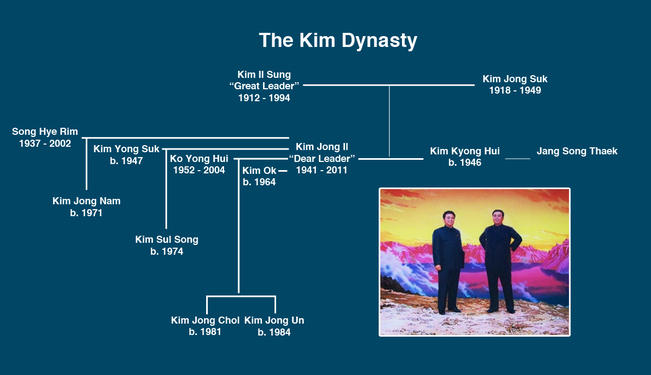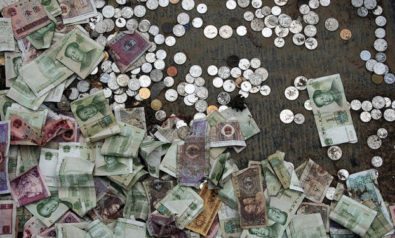
North Korea, or the Democratic People’s Republic of Korea (DPRK), is considered to be one of the most isolated countries in the world. The “Great Leader” Kim Il Sung developed his own personal brand of communism, Juche, which taught self-reliance and independence in all aspects of the state.
North Korea is in fact a country moulded by external forces. Imperial Japan controlled the Korean peninsula for the first half of the 20th century, and the USSR occupied the northern zone after WWII, supporting Kim Il Sung in the construction (and attempted expansion) of a socialist state. The border between the two Koreas, manned by one million troops on each side as well as several thousand American troops, is in itself a foreign creation. It was hastily sketched out in Washington, halving the nation as a measure to prevent Soviet forces from taking over the whole country after Japan’s capitulation at the end of WWII. A source of fascination for the outside world, the country is often perceived as an Orwellian totalitarian state. The relentless propaganda and control over citizens’ access to information fuels the belief in the state and the people as one entity. As an outsider it is extremely difficult to meet regular citizens and knowledge about their everyday lives is limited.
The Kim Dynasty
The focal point of North Korea’s identity for its citizens has been its leaders. A personality cult after the Korean War elevated the “Great Leader” Kim Il Sung to a God-like figure and his image and declarations became untouchable. To this day, Kim Il Sung is still the country’s leader, the “Eternal President.” After his death in 1994, his son Kim Jong Il, the “Dear Leader”, took over daily business. Kim Jong Il died in December 2011 and was succeeded by his son Kim Jong Un, the “Great Successor”.
From Colony to Divided State
The Korean peninsula was annexed by Japan in 1910, the beginning of a brutal 35-year occupation during which Korean national identity was suppressed. In 1945, Korea was temporarily occupied by Soviet forces in the north and British and US forces in the south until countrywide democratic elections could be held. No agreement was reached and Kim Il Sung, head of the Communist Party, was endorsed by Stalin as leader in 1946. With the Soviet leader’s approval, Kim and his forces crossed the 38th parallel, marking the beginning of the Korean War in June 1950. This was both an internal and an external conflict: a civil war and the first major conflict of the Cold War. It was fuelled by opposing superpowers with vast resources, resulting in an extended and devastating war. After almost two years of talks, an armistice was reached in July 1953 and the 38th parallel remained the dividing line between the two states. Both sides claimed to be victorious and no peace treaty has ever been signed. Roughly 10% of Koreans had been killed, injured, or were missing in this conflict.
New construction as well as reconstruction followed. The 1960s saw astounding development in North Korea under strict control of the Communist regime, which collectivised industry and agriculture. After Japan, North Korea was Asia’s most developed country at this time. Now, in contrast, North Korea shows up as blackness surrounded by its neighbours’ bright lights on night-time satellite pictures. The economy faltered in the 1980s, and the regime purportedly involved itself with drug dealing and other shady activities to finance its spending. After the collapse of the Eastern Bloc in 1989, North Korea’s list of allies shortened considerably. Come the 1990s, it was unable to feed its own people. It is estimated that two million people died from food shortages.
A Nuclear Threat?
Such an economically insignificant state would not warrant so much international attention if it were not, in part, due to its nuclear programme, kick-started by the instalment of the Yongbyon reactor in 1962. Restricted by sanctions, the government has claimed it must find alternative ways to fill its energy needs. In its on-again, off-again negotiations with the US and the UN, its nuclear capability has been a powerful card to play. Pyongyang has stopped and resumed its nuclear activities several times over the years, often openly and pointedly. When, in 2002, George Bush dubbed the state part of an “axis of evil”, Pyongyang reactivated its Uranium enrichment plant. In 2006 and 2009 Pyongyang claimed to have conducted successful nuclear testing, much to the concern of the international community.
Relations in the peninsula have fluctuated in recent years. The then South Korean president, Kim Dae Jung, adopted a “sunshine policy” to harmonise relations with aid and talks, reaching an unprecedented summit between the two Korean leaders. Lee Myung Bak, South Korea’s current president, has consciously stopped this policy and under the Bush administration food aid supplies have been significantly reduced. Diplomacy worsened in 2010 when the South accused the North of sinking one of its warships, which the latter denied.
Figures
Population: 24 million
Military personnel: 1.2 million
Area: 47, 399 sq. miles
For more than 10 years, Fair Observer has been free, fair and independent. No billionaire owns us, no advertisers control us. We are a reader-supported nonprofit. Unlike many other publications, we keep our content free for readers regardless of where they live or whether they can afford to pay. We have no paywalls and no ads.
In the post-truth era of fake news, echo chambers and filter bubbles, we publish a plurality of perspectives from around the world. Anyone can publish with us, but everyone goes through a rigorous editorial process. So, you get fact-checked, well-reasoned content instead of noise.
We publish 2,500+ voices from 90+ countries. We also conduct education and training programs on subjects ranging from digital media and journalism to writing and critical thinking. This doesn’t come cheap. Servers, editors, trainers and web developers cost money.
Please consider supporting us on a regular basis as a recurring donor or a sustaining member.
Support Fair Observer
We rely on your support for our independence, diversity and quality.
Will you support FO’s journalism?
We rely on your support for our independence, diversity and quality.











